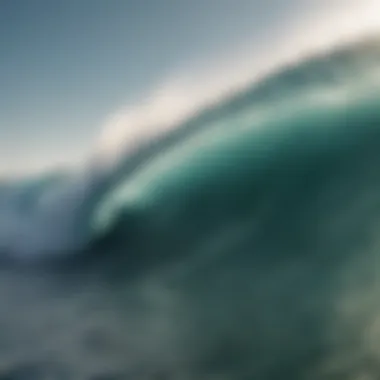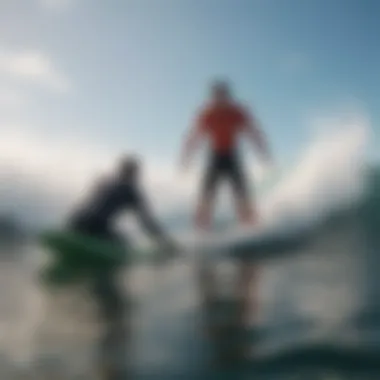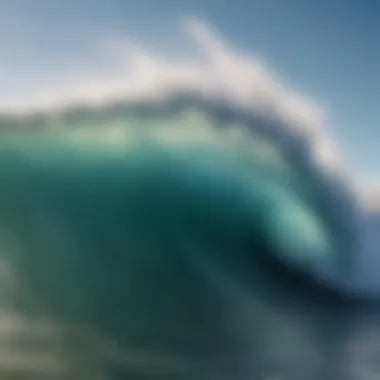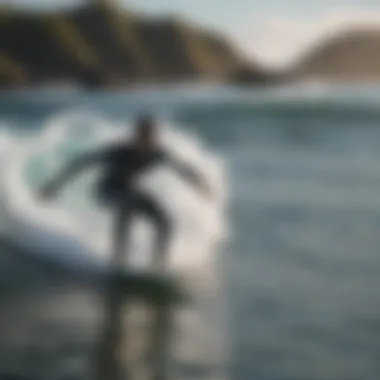Understanding the Swell Report for Watersports Enthusiasts


Intro
Wave enthusiasts often rely on swell reports to understand the best conditions for their activities. This article explores the crucial elements of swell reports, which serve a central role in various water sports, such as surfing, sailing, snorkelling, and paddleboarding. Knowledge of these reports enables enthusiasts to make informed decisions, enhancing their enjoyment and safety while engaging with the water.
As we delve into the workings of swell reports, understanding factors like wave height, period, and direction is essential. This foundational knowledge will arm both beginners and experienced lovers of water sports with criteria to track optimal conditions for their adventurers.
Water Activity Overview
Water sports are diverse and vary in skill level, equipment needs, and safety considerations. Each activity has unique dependencies on the swell. Here, we present four primary water activities and their relation to swell conditions.
Surfing
Surfing is often considering the flagship of watersports, with quality waves dictating the experience of every surfer. Surfers closely monitor the swell forecasts for wave height and direction. For example:
- Wave height: Ideal waves for surfing vary between 2 and 10 feet, depending on the surfer’s skills.
- Swell period: A longer period (10 seconds or more) often indicates powerful and well-formed waves, while a shorter period may mean less consistent conditions.
- Direction: Direct incidence of swells on the chosen surf spot can create a more favorable approach for catching waves.
Sailing
Sailors also need accurate swell reports to rely on planning navigation agendas. The size and direction of the swell affect wind conditions, which are central to manipulative rigs used in boats. They pay special attention to:
- Swell period: A consistent period reinforces effective navigation efforts during a sail, reducing the effort made against irregular wave patterns.
- Wind speed: It must accompany the swell forecast, as strong winds can either aid or hinder sailing performance.
Snorkeling
For underwater exploration, knowing the surface conditions of the waves plus the tide adds a layer of safety for snorkelers. Professionals suggest:
- Low wave height: Optimal conditions would typically aim for a wave height under 2 feet.
- High visibility: It captures merges as surf conditions remain placid, aiding frame spots for marine life curiosity.
Paddleboarding
Paddleboarding benefits from a mix of surfing and high visibility specs. Optimal paddling may seek formations that provide slight waves for a good workout or exploration. Important metrics include:
- Swell height: Preferably set under 3 feet to maintain steady balancing and control with limited struggle over swells.
- Calm waters: Enthusiasts enjoy gentle conditions for long homeward adventures and scenic excursions.
Tips and Techniques
To enhance water activities, it helps to apply certain tips tailored to diverging experience levels and concerns. The following points reflect those distinctions:
Tips for beginners
- Know your gear: Becoming familiar with your equipment ahead of time ensures safety in unpredictable waters.
- Observe conditions: Read swell reports to gauge weather conditions before venturing out.
- Start small: Choose locations that offer gentler conditions and beginner-friendly waves.
Advanced techniques for experienced enthusiasts
- Understanding currents: With experience, understanding how swells affect tidal changes guides optimal positioning during the water sport.
- Refining skills: Advanced surfers may practice on boards suited for diverse swells, over adaptability brings strength from proficiency.
Safety guidelines
- Check forecasts regularly: Swell conditions can shift rapidly; staying informed means staying safe.
- Buddy up: Always involve others during activities. Sharing experience fosters collective knowledge manipulations like excavation.
Intro to Swell Reports
Definition and Purpose
A swell report is a compilation of information that describes the state of ocean waves. Its main purpose is to provide data to watersports enthusiastns, helping them understand when conditions are optimal for activities such as surfing, sailing, and paddleboarding. A well-structured swell report typically includes measurements like wave height, period, and breaking direction. This is crucial because different water activities require different wave conditions to be enjoyable or safe.
Essentially, a swell report functions as a guide. It tells users what they can expect from the ocean at any given time, taking various factors into account. Understanding the terminology and the metrics in these reports can greatly enhance a user's experience on the water.
Importance for Watersports Enthusiasts
For anyone engaging with the ocean, the swell report is incredibly important. It provides critical insights that help individuals plan expeditions better. By interpreting the data, enthusiasts can avoid dangerous and unpredictable conditions, improving both safety and customization of their experience.


- Improving Safety: Knowledge of wave height and currents can forewarn enthusiasts about potential hazards.
- Optimizing Performance: Specific wave conditions may enhance the experience for activities like surfing and sailing. Knowing what suits your activity helps in selection and success.
- Facilitating Planning: Access to reliable data allows for better itineraries and scheduling, making the most out of valuable time on the water.
In summary, swell reports are essential for anyone involved in water activities. They provide a framework for not only ensuring safety but also enhancing enjoyment through informed decision-making.
Understanding Wave Dynamics
Understanding wave dynamics is essential for watersports enthusiasts. This section covers how waves form and the factors that affect them. Knowing these elements partains directly to their recreational activities and shapes the overall experience. Having insight into wave dynamics allows enthusiasts to make well-informed decisions and adapt to conditions for improved safety and enjoyment.
Formation of Swells
Swells are created through a combination of wind and sea factors. The first stage of storm development over an ocean or sea generates waves, which when combined, can create swells. Swells can travel long distances away from where they are generated. The longer the waves travel, the more energy they gather and they usually become more defined. Understanding how swells form is crucial for anyone engaging in watersports activities. For example, surfers tailor their outings based on when and where pulsing swells will reach the shore.
Factors Affecting Swell
Three critical aspects—the wind patterns, ocean currents, and seafloor topography—significantly influence swells.
Wind Patterns
Wind patterns are a key influence on swell formation. The strength and consistency of the wind determine how size and quality of waves evolve. A sustained wind blowing over a longer fetch—an area over which the wind blows—generates larger swells. These winds, also relying on speed can result in different sizes of waves, which are relevant for different watersports. One consideration is that winds can shift quickly, and thus predicting any changes can point to favorable or unfavorable conditions.
Ocean Currents
Ocean currents play a rather important role in modifying existing swells. Some swells are amplified or slowed down depending on the type and direction of the current. An offshore current, which moves toward deeper water, tends to help preserve the energy of swells. However, coastal currents can erode wave energy during approach to the shore. Understanding how these currents transform swell behavior can guide wait times for activities such as sailing; those currents offer advantages too.
Seafloor Topography
Seafloor topography affects how waves break when reaching the shore. The shape of the seabed plays a big role here. For notable example, steep underwater cliffs can create substantially dynamic waves as opposed to flatter seabeds.Depth and features such as reefs also critically govern where waves will break. For enthusiasts who enjoy specific activities, recognizing which spots have desirable seabed characteristics enhances their experience.
With this understanding of wave dynamics, watersports participants are more prepared for nature’s variability and challenge.
Components of a Swell Report
Swell reports deliver vital data that helps watersports enthusiasts make informed decisions when participating in activities. In this section, we delve into the critical components of a swell report, namely wave height, wave period, wave direction, and tide/current info. Understanding these elements is key to ensure both safety and enjoyment on the water.
Wave Height
Wave height refers to the vertical distance between the crest and the trough of a wave. This measure is crucial for evaluating surf conditions, especially for surfers and paddleboarders.
High waves can present excellent conditions for experienced surfers but might be dangerous for newer enthusiasts. Understanding how to interpret this measurement helps watersports enthusiasts decide if conditions match their skill levels. Generally, if the wave height reaches above your waist, it may indicate rising difficulty.
It is essential to know range from the conditions when looking at wave height:
- 1-2 feet: Suitable for beginners
- 3-5 feet: Good for average skill levels
- 6 feet and above: Challenging, only for skilled athletes
Wave Period
The term wave period describes the time it takes for two successive wave crests to pass a fixed point. Wave period serves as an indicator of wave stability. Longer periods create smoother waves, while shorter periods can indicate choppy conditions. This stability can impact various watersports. For surfers, a wave period of ten seconds or more often results in better surf conditions. Understanding this metric can forewarn potential risks or opportunities for many enthusiasts.
Wave Direction
Wave direction indicates the origin from which the waves are approaching land. It significantly affects surf quality, prevailing currents, and water conditions. Wave directions are often reported in degrees, providing clarity on how waves will break at the chosen spot. Applications such as coastal surfing reports often provide visual representation, making the direction more understandable for watersports enthusiasts.
From the perspective of surfers, a wave that approaches straight on usually leads to more powerful breaks, whereas oblique angles can create inconsistent conditions. Recognizing wave direction can determine whether a surf spot is appropriate for the day's conditions.
Tide and Current Information
Tide and current data are parameters that comprise the dynamics of any water activity. Tides change according to gravitational forces and a host of local factors. This cyclical movement influences water depth, wave formation, and spots preliminary conditions.
Awareness of tidal effects needs to be intensified, particularly for navigational sports like sailing and kayaking. Current reports help enthusiasts steer clear from negative situations, especially in areas known for strong and ripping currents.
Reading and Interpreting Swell Reports


Reading swell reports effectively is crucial for watersports enthusiasts. It is more than just understanding numbers; it encompasses analyzing multiple facets of the report to make informed decisions. A swell report combines vital elements such as wave height, swell period, and wind conditions. Understanding these factors ensures that watersport activities like surfing, sailing, or paddleboarding can be conducted safely and at optimal times. Additionally, comprehending swell reports enhances the user's overall experience on the water.
How to Read a Swell Report
Learning the practical steps to read a swell report begins with identifying key components. Look for the following:
- Wave Height: This is the distance from the trough to the crest of the wave. It indicates how challenging or dangerous the conditions may be.
- Wave Period: The time between two waves, measured in seconds. A longer period typically means more powerful and organized waves.
- Direction: Each swell has a primary direction, affecting how the waves interact with the coastline.
- Wind Speed and Direction: These will alter wave conditions. Therefore, storm patterns or light breezes can implicitly affect your outing.
When looking at these components, start by identifying any 'forecast bars' or visual indicators commonly found in swell platforms. They provide a full snapshot of anticipated conditions.
Common Terminology Explained
Understanding commonly used terms in swell reports promotes better interpretation. Here are several key definitions:
- Swell: Refers to waves generated by distant weather systems. It can consist of multiple wave sets.
- Fetch: The distance wind travels across the water surface. A longer fetch creates more significant swells.
- Ground Swell vs. Wind Swell: Ground swells are created by distant storms. In contrast, wind swells are from local winds.
- Chop: Refers to shorter and rough waves, often caused by local winds. They are less desirable for many watersports.
Awareness of these terms allows enthusiasts to navigate reports with more accuracy.
Practical Examples
Consider practical scenarios of reading swell reports:
- Surfing: You identify a swell with an 8-foot wave height and a 15-second period. This indicates a powerful incoming swell ideal for advanced surfers. Your pre-surf planning should factor in the wind conditions—side-shore winds may make things choppy ☑️.
- Sailing: Suppose a swell report indicates 3-foot swells with a moderate wind forecast. In this can be a pleasant route for midday sails, assuming no significant storms unwind near your cruising area.
- Paddleboarding: If you note 1-2 feet of swell height and a very short period, you could expect manageable conditions. Almost flat seas are ideal for beginners or leisurely paddlers.
Reading swell reports is essential for safe and enjoyable watersport activities. It provides not only current wave conditions but also insights for future planning and enhancing performance.
Swell Reports for Different Watersports
Swell reports are pivotal for enthusiasts across various forms of watersports, impacting decisions, safety, and enjoyment. Each sport, whether it be surfing, sailing, paddleboarding, or kayaking, has distinct requirements from the swell and wave dynamics. Understanding how specific swell characteristics affect each activity enhances the experience of being on the water. Here, we dissect the importance of swell reports for different watersports, noting advantages and unique considerations for each.
Surfing
For surfers, swell reports dictate not just when to surf, but where to surf. The subtle changes in wave height and direction can transform a mediocre beach into a prime surf location. Understanding wave periods—which can dictate whether the waves are peaky and sharp or gentle and rolling—can help surfers gauge the kind of ride they can expect.
Key Considerations for Surfing:
- Wave Height: Surfing typically demands larger swells. Ensuring that wave heights are adequate for the desired difficulty level is crucial.
- Swell Direction: Some surf spots are better suited to certain swell directions. Knowing this can lead to a successful session.
- Wind Conditions: Offshores winds improve wave shape and quality; thus, surfers should check these beforehand.
Understanding local geographic features is as important as reading a swell report.
Sailing
Sailing, influenced greatly by wind patterns in addition to wave conditions, requires an understanding of how swells will affect navigation. A sailor must assess not only the size of the waves, but also their frequency, as closely spaced swells can pose significant challenges for maneuverability.
Important Elements for Sailing:
- Conditions Ahead: Reading swell reports provides foresight into future wind changes that may affect sailing conditions.
- Safety Precautions: Smaller swells might allow for smoother sailing, while larger swells require heightened safety measures.
- Route Planning: Knowing the swell can assist sailors in charting a more pleasant sailing route with less unwanted motion.
Paddleboarding
Paddleboarding is less demanding than surfing for wave size, yet knowledge of swell conditions is still crucial. Enthusiasts must recognize how swells might impact their stability and steering.
Considerations for Paddleboarding:
- Ease of Navigation: Calm conditions with small wave sizes enable beginners and intermediates to practice safely.
- Wave Patterns: Some experienced paddlers might seek choppy conditions for practice or fun, which can be noted in swell reports.
- Environmental Factors: Wind can exacerbate wave conditions, emphasizing the importance of timely weather checks along with swell analysis.
Kayaking
Kayaking swells serve as both an enticing challenge and a potential hazard. Enthusiasts require person-specific condition evaluations: for recreational paddlers, tranquility is favored, while adventurers may look for thrilling waves.
Key Pointers for Kayaking:


- Adaptable Conditions: Like other water-bound activities, kayakers must be prepared based on swell forecasts—without appropriate knowledge, even calm waters can become deceptively difficult rapidly.
- Stability Awareness: Smaller and mid-sized waves may improve thrills but can also threaten stability.
- Experience Level: Those with increased skill should take advantage of higher swells for excitement, but it is paramount to respect one’s limitations.
Impact of Weather on Swell Reports
Weather plays a critical role in shaping swell conditions that watersports enthusiasts depend on. Swell reports inherently combine various elements of meteorology with oceanography. This connection establishes how wave heights, intervals, and directions may shift with changing weather patterns.
Understanding these dynamics is essential for making educated choices regarding timing and locations for activities like surfing, sailing, paddleboarding, and kayaking. A poor awareness of prevailing weather conditions can cause both safety issues and ineffective use of time on the water.
Weather Patterns and Swell Formation
Different weather patterns can influence ocean conditions and resulting swells. High-pressure systems often bring stable conditions with minimal winds, creating a calm ocean surface. In contrast, low-pressure systems tend to generate heavier winds and more chaotic conditions, leading to larger and more irregular swells.
Winds serve as the main driving force behind wave creation. Sustained winds over long distances facilitate wave stacking, which is essential for developing proper swells. The wind direction, intensity, and duration could shape the swells and their approach to different coasts. Additionally, storms have the potential to create large swells that transition over vast ocean distance before impacting local shores.
Factors to consider regarding weather patterns include:
- Wind speed and direction: Establish how wave energy accumulates and propagates.
- Storm systems: Can cause significant swell activity that may affect water sports players in both positive and negative ways.
- Tide changes: Different tidal phases change the depth and shape of coastal zones, potentially impacting coming waves.
How to Prepare for Changing Conditions
Watersport enthusiasts should know how to adjust their plans according to fluctuating weather conditions. Here are ways to prepare for changes in swell conditions:
- Check real-time weather and swell reports frequently: Use reliable mobile apps like Windy or Surfline for the latest updates.
- Understand local conditions better: Familiarize yourself with location-specific weather patterns and historical trends to debate their impact on swells.
- Stay updated on advancing storms: Recognize how storm systems may shift movements of swells in unpredictable ways.
- Individuals should wear appropriate gear: Unpredictable weather may lead to drastic changes in temperatures and conditions, requiring cold weather or rainguard equipment.
Keeping informed and prepared enhances the overall safety and enjoyment of water experiences. Recognizing the relationships between weather patterns and swell reports gives enthusiasts the tools needed to optimize their timing.
Integrating Technology with Swell Reports
Technology plays a vital role in the accessibility and understanding of swell reports. In today's fast-paced world, watersports enthusiasts rely on various technological advancements to make informed decisions on when and where to engage in their activities. Integrating technology with swell reports goes beyond mere convenience; it enhances our ability to analyze complex data in a streamlined way. Through mobile applications and online platforms, access to critical information about wave conditions and weather forecast are more straightforward than ever.
Mobile Applications
Mobile applications have transformed how enthusiasts access swell reports. These apps provide real-time data with user-friendly interfaces, making it easier for everyone, from beginners to experts, to obtain the latest information on wave height, period, and direction. Popular apps like Windy and Surfline allow users to check conditions anywhere, anytime, ensuring they stay updated before heading to the water.
Key benefits of mobile applications include:
- Real-Time Updates: Notifications keep users informed about sudden changes in water conditions.
- Personalization: Many apps let you set preferences based on your preferred watersport, enabling tailored notifications.
- Mapping Features: Access to live maps helps identify nearby spots with optimal conditions.
- Community Insights: Some apps, like Wavestorm, include user-generated reports, giving real perspectives on local conditions.
Understanding how to utilize these tools can significantly enhance the quality of time spent on the water.
Online Platforms
Online platforms complement mobile applications by offering more comprehensive data analysis. Websites like Magicseaweed and NOAA provide deep dives into surf forecasts, going beyond casual data to present a more analytical perspective. They allow users to compare historical data, analyze patterns, and predict upcoming conditions.
Essential aspects of online platforms include:
- In-Depth Data: Enhanced graphs and charts portray complex data points clearly for informed decision-making.
- Forecast Models: Advanced statistical models secure broad insights, helping predict swells and tide patterns.
- Community Forums: Online interactions with other watersports enthusiasts allow for knowledge sharing and increased locale understanding.
Overall, integrating technology with swell reports is significant. It gives users valuable tools to enhance their watersport activities. By leveraging mobile applications for real-time updates and online platforms for deeper analysis, enthusiasts gain a notable advantage when planning outings,and create memorable experiences on the water.
"Understanding the intricate relationship between technology and swell reports can considerably enhance one’s adventures on the water."
Epilogue
Swell reports hold intrinsic value for all who partake in watersports. Their significance cannot be overstated when considering safety, planning, and enhancing overall experience on the water. This article aims to synthesize essential information about swell reports, making it accessible for both newcomers and those experienced in watersports.
Summary of Key Points
- Understanding Wave Conditions: Analyzing wave height, period, and direction are crucial for selecting suitable activities.
- Importance of Weather: Recognizing how weather influences swell reports allows for more precise planning.
- Technology Integration: Mobile apps and online platforms offer innovative ways to receive real-time updates.
- Practical Applications: The insights gleaned can lead to improved decision-making for all activities from surfing to kayaking.
Each component plays a role in maximizing one’s time spent on the water.
The Role of Swell Reports in Enhancing Watersports Experiences
Swell reports equip enthusiasts with important data needed to capture the best moments on the ocean. Knowledge derived from these reports directly improves the ability to identify favorable conditions for specific watersport activities. The presence of adequate wave height and desirable periods means better performance and safety during is crucial. In contrast, tackling the waves without proper knowledge can pose risks and affect enjoyment.
Ultimately, by harnessing the information provided in swell reports, enthusiasts attain better mastery over their chosen watersport. Effectively utilizing these reports fosters not only an enhanced experience but also safety, making it a vital tool for anyone engaging with dynamic water environments.
“Knowledge is power; applying that knowledge is crucial to enjoying watersports safely.”















